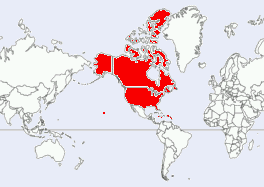 | ||||||||||||||
|
Contents
| ||||||||||||||
| ||||||||||||||
|
| |||
NANP
The North American Numbering Plan (NANP) spells out how telephone numbers can be allocated in North America and some of the "adjacent" areas. Whether you live in New Mexico, Nunavut, the Cayman Islands, or Grenada, the NANP defines what your area code is and -- within that -- what exchanges prefixes can be used. Area CodesThe format for telephone numbers in North America is relatively straight forward. The first three digits identify the are code, the next three digits identify the local exchange (also known as a "central office" or "CO") and the last four digits identify individual phone lines. Most area codes belong to specific geographical areas. Some area codes cover large geographic areas (867 cover millions of square miles, most of which are frozen) while others cover relatively tiny areas (671 covers the micronesian island of Guam which is all of 212 square miles). Some area codes, such as 710 (US Government), 800 (toll-free) or 900 (premium sevices), are not associated with specific geographic regions. As the population grows and develops a need fax machines, cell phones, pagers, and extra lines for the teenager in the family, the pool of unused telephone numbers -- theoretically just under 10 million but in practice much less due to certain numbering restrictions -- is depleted, and a new area code must be set up. At that point a decision needs to be made: overlay or split. Both have the pro's and con's and both cause some degree of pain to callers. Area Code OverlaysIn the Overlay scenario, the new are code covers the same geographical are as the old area code. The new area code represents a pool of new telephone numbers which can be handed out to new customers. Old customers keep their telephone numbers, which is nice in the first few years, especially if you get a lot of calls from other area codes. However this technique creates an additional burden for the rest of time because you can no longer deduce somebody's area code from their phsical localtion. Your new next door neighbour may be in a different area code, or they may not. This means that there is no longer such a thing as a seven digit local number. Area Code SplitsIn the Split scenario, the geographical area of the old area code is divided into two portions and all the telephones in the one of the two portions are "moved over" to the new area code. Those exchange prefixes whose telephones were moved can now be assigned new telephones in the old area code, and the prefixes whose telephones did not move can be assigned new phones in the new area code. In the short term, there is some annoyance as callers from other area codes update the area code portion of the callees phone numbers (for those regions that were mapped to the new area code), but in the long term you maintain the benefit of being able to use seven digit numbers locally. You can split an area code several times and maintaining the ability to have seven digit local numbers, but once you do an overlay, that ability is lost forever. Special Area CodesThe NANP defines several special area codes that are not associated with geographical areas. These are 456 for Inbound International calls, 500 for Personal Communication Service, 600 for Canadian Services, 700 for Interexchange Carrier Services, 710 for the US Government, 800/866/877/888 for Toll-Free numbers, and 900 for Premium Services. Special Exchange PrefixesThe NANP also reservers certain local exchange prefixes for special uses. The "555" prefix, for instance, is reserved for information services available in several area codes (such as "555-1212" for directory services). In Canada, prefixes such as "604", "416", and "902", are reserved because they also happen to be valid Canadian area codes. "911" (and 912, 913, 914, 915, and 916) also cannot be used as an exchange prefix because they are too similar to 911 (emergency services). | |||
